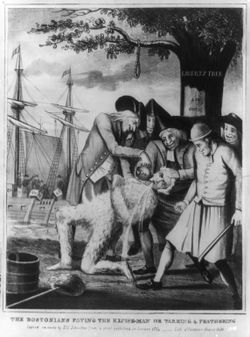Liberty Tree

The Liberty Tree was an iconic tree in Boston Commons during the Stamp Act crisis[2] that colonists rallied around as a symbol of strength.
Popular across the Thirteen colonies, Liberty Trees were used as meeting places to plan resistance and to stage various acts of defiance such as rallies and Protest against the King.[3]
Contents
Background
The Sons of Liberty used to rally under its wide-spreading branches. It was under this tree that the first public act of resistance to British tyranny showed itself. At dawn, on the 14th of August, 1765, an effigy of Andrew Oliver, the stamp officer, was discovered hanging to one of the larger branches, which caused great excitement. The sheriff was ordered by the colonial Governor Hutchinson to remove the effigy from the tree. But such was the intensity of public feeling, he declared he dare not do so. It was creating a local revolution, and was removed by stratagem. The tree became famous about 1760, and was named the Liberty Tree about this time. On Feb. 14, 1766, it was pruned by the order of the Sons of Liberty.
The ground about the tree had become sacred soil, and was designated as "Liberty Hall",[4] and really became the original stamping ground of the Revolution, in defiance of the "stamp act." In 1767 a flagstaff was erected, which went up through the branches, upon which was hoisted a flag as a signal for the assembling of the Sons of Liberty. In August, 1775, the Tories, encouraged by their British allies, and led on by one Job Williams, armed with axes, made a furious attack upon the Liberty Tree, and it was ruthlessly cut down. This vandal act caused great excitement. At the close of the Revolution a liberty pole was erected on the stump of the old tree which long served as a point of direction.[5]
Dedication
The dedication of the Liberty Tree was given by a Son of Liberty named Silas Downer.
Symbolism
For a more detailed treatment, see Natural Law.
Under the waving branches of those old trees, the inspiration of Nature aided song and oratory in the cry against oppression.[6]
Additionally, the tree stood as a symbol for unwavering strength. Many poems and inscriptions were inspired by the Liberty Tree and the actions that had taken place there. Ezra Stiles noted two such inscriptions:
What greater Joy did ever New England see
- Than a Stampman hanging on a Tree[7]
Fair Freedoms glorious Cause I meanly Quitted,
- Betrayed my Country for the Sake of Pelf,
- But ah at length the Devil hath me outwitted,
- Instead of stamping others have hanged my Self.[7]
Pine Tree Flag
For a more detailed treatment, see Pine Tree Flag.
The Liberty Tree appears on the flag for Washington's Cruisers, a small fleet of ships that comprised Massachusetts Navy. The flag is white, with a green tree in the middle, and across the top of the flag are the words An Appeal To Heaven.
Thomas Paine's poem
Like many other patriots of his era, Thomas Paine found inspiration in the Liberty Tree. Here is a poem that he wrote:[8]
| “ |
In a chariot of light from the region of day, |
” |
See also
References
- ↑ See the 1794 Liberty Cap coin
- ↑ Liberty Tree. The Freedom Trail Foundation.
- ↑ Why ‘Liberty Trees’ Became an Obsession After the Revolutionary War
- ↑ (1896) Under the Liberty Tree; Stories of American History.
- ↑ (1907) Little Pilgrimages Among Old New England Inns: Being an Account of Little Journeys to Various Quaint Inns and Hostelries of Colonial New England, 84–85.
- ↑ (1896) The historic Boston Tea Party of December 16, 1773: its men and objects : incidents leading to, accompanying, and following the throwing overboard of the tea, including a short account of the Boston Massacre of March 5, 1770, with patriotic lessons therefrom adapted to the present time, 18.
- ↑ 7.0 7.1 Extracts from the Itineraries and Other Miscellanies of Ezra Stiles, D. D, Ezra Stiles to John Avery, August 19th, 1765
- ↑ The historic Boston Tea Party of December 16, 1773, 19.
| |||||||||||||||||
